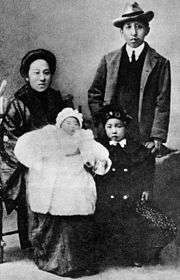Liao Zhongkai
Liao Zhongkai (April 23, 1877 – August 20, 1925) was a Chinese-American Kuomintang leader and financier. He was the principal architect of the first Kuomintang–Chinese Communist Party (KMT–CCP) United Front in the 1920s. He was assassinated in Guangzhou in August 1925.[1]
Liao Zhongkai | |
|---|---|
廖仲愷 | |
 | |
| Member of the Executive Committee of the Kuomintang | |
| In office 1925–1925 | |
| Premier | Sun Yat-sen |
| Minister of Finance of the Kuomintang | |
| In office 1921–1925 | |
| Personal details | |
| Born | April 23, 1877 San Francisco, California, United States |
| Died | August 20, 1925 (aged 48) Guangzhou, Guangdong, China |
| Nationality | Qing dynasty (1877-1912) Republic of China (1912-1925) |
| Political party | Kuomintang |
| Spouse(s) | He Xiangning |
| Children | Liao Mengxing, Liao Chengzhi |
| Parents | Liao Zhubin |
| Education | Queen's College, Waseda University, Tokyo University |
| Liao Zhongkai | |||||||||||
|---|---|---|---|---|---|---|---|---|---|---|---|
 Liao Zhongkai, He Xiangning and children in 1909 | |||||||||||
| Traditional Chinese | 廖仲愷 | ||||||||||
| Simplified Chinese | 廖仲恺 | ||||||||||
| |||||||||||

Early life
Liao was born in 1877 in San Francisco and received his early education in the United States. He was one of twenty-four children. His father Liao Zhubin, who had five wives, was sent to San Francisco by the Hong Kong and Shanghai Bank.
Returning to Hong Kong in 1893, at the age of sixteen he studied at Queen's College from 1896. He married He Xiangning in 1897. He then went to Japan in January 1903 to study political science at Waseda University. In 1907 he went to Chuo University to study political and economic science.
In politics

Liao joined the Chinese Revolutionary Alliance in 1905 upon its founding and became the director of the financial bureau of Guangdong after the founding of the Republic of China.
In the early struggles of the party, Liao Zhongkai was arrested by Guangdong strongman Chen Jiongming in June 1922. After Chen's defeat Liao became Civil governor of Guangdong from May 1923 to February 1924, and then again from June to September 1924. During the first Kuomintang–Chinese Communist Party cooperation period, he was appointed to the Kuomintang Executive Committee.
When the KMT was reformed in 1924, he was named the head of the Department of Workers, and then Department of Peasants. Later he became Minister of Finance of the southern government, seated in Guangdong. When Sun Yat-sen died in Beijing in March, 1925, and Liao was one of the three most powerful figures in the Kuomintang Executive Committee, the other two were Wang Jingwei and Hu Hanmin.
Liao continued his belief in Sun's policy after he died, including one of the key policies of maintaining close relations with the Soviet Union as well as the Chinese Communist Party, which was strongly opposed by the KMT right wing. Liao was assassinated before a Kuomintang Executive Committee meeting on August 20, 1925 in Guangzhou, when five gunmen riddled him with bullets from Mauser C96s as he stepped out of his limousine. Suspicion for the act fell upon Hu Hanmin, who was then arrested. This left only Wang Jingwei and the rising Chiang Kai-shek as rivals for control of the Kuomintang.
Liao and He Xiangning had a daughter, Liao Mengxing, and a son, Liao Chengzhi. The latter had four sons, Liao Hui being the eldest. Anna Chennault is his niece.
References
- Kurt Werner Radtke; Chengzhi Liao (1990). China's Relations With Japan 1945-83: The Role of Liao Chengzhi. Manchester University Press. pp. 23–. ISBN 978-0-7190-2795-6. Retrieved 4 January 2013.
Further reading
- Itoh, Mayumi (August 2012). Pioneers of Sino-Japanese Relations: Liao and Takasaki. Palgrave-MacMillan. ISBN 978-1-137-02734-4.
External links
| Wikimedia Commons has media related to Liao Zhongkai. |
- Rulers; Index Li-Ll, Liao Zhongkai biography
- 廖仲愷簡介 biography with photo